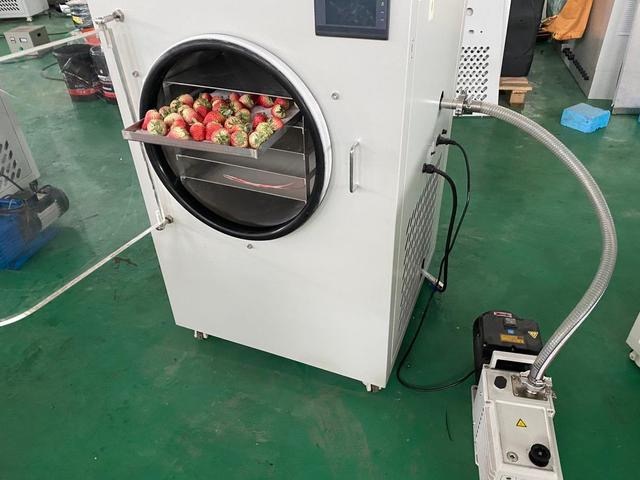
Content Menu
● Introduction to DIY Freeze Drying
● Understanding the Freeze Drying Process
● Home Freeze Drying Methods
>> 1. The Freezer Method
>>> Steps:
>> 2. Dry Ice Freeze Drying
>>> Steps:
>> 3. Vacuum Chamber Method
>>> Steps:
● Tips for Successful Home Freeze Drying
● Best Foods for Home Freeze Drying
>> Fruits
>> Vegetables
>> Meats
>> Dairy
>> Meals and Snacks
● Advantages of Freeze Drying Food at Home
● Challenges and Limitations
● Storing and Using Freeze-Dried Foods
● Creative Uses for Home Freeze-Dried Foods
● Comparing Home Methods to Commercial Freeze Dryers
>> Advantages of Home Methods
>> Advantages of Commercial Freeze Dryers
● Conclusion
● Frequently Asked Questions
>> Q1: How long do home freeze-dried foods last?
>> Q2: Can all foods be freeze-dried at home?
>> Q3: Is freeze-drying better than dehydrating?
>> Q4: How do I know when my food is completely freeze-dried?
>> Q5: Can I freeze-dry liquids using home methods?
Introduction to DIY Freeze Drying
Freeze drying is a remarkable food preservation technique that has gained popularity among home cooks, preppers, and food enthusiasts. While commercial freeze dryers can be expensive, there are several DIY freeze drying methods that allow you to achieve similar results without breaking the bank. In this comprehensive guide, we'll explore how to freeze dry food without a machine, discussing various techniques, their pros and cons, and tips for success.
Understanding the Freeze Drying Process
Before diving into the methods, it's essential to understand what freeze drying is and how it works. Freeze drying, also known as lyophilization, is a process that removes moisture from food by first freezing it and then reducing the surrounding pressure to allow the frozen water to sublimate directly from ice to vapor. This process helps maintain the food's structure, flavor, and nutritional value while significantly extending its shelf life.
Home Freeze Drying Methods
Let's explore some of the most effective home freeze drying methods that don't require expensive equipment.

1. The Freezer Method
The freezer method is the simplest and most accessible way to freeze dry food at home. While it takes longer than other methods, it requires no special equipment beyond your regular freezer.
Steps:
1. Prepare your food by washing, slicing, or chopping it into small, uniform pieces.
2. Arrange the food in a single layer on a baking sheet or tray.
3. Place the tray in your freezer, ensuring it's set to the coldest setting.
4. Leave the food in the freezer for 2-3 weeks, checking periodically for dryness.
5. Once the food is completely dry and brittle, store it in airtight containers or vacuum-sealed bags.
2. Dry Ice Freeze Drying
The dry ice method is faster than the freezer method and can produce results more similar to commercial freeze dryers.
Steps:
1. Prepare your food as in the freezer method.
2. Place a layer of dry ice at the bottom of a cooler or insulated container.
3. Put your prepared food on a tray or rack above the dry ice, ensuring it doesn't come into direct contact.
4. Cover the cooler, leaving it slightly open to allow gas to escape.
5. Leave for 24-48 hours, replacing dry ice as needed.
6. Once the food is completely dry, store it properly.
3. Vacuum Chamber Method
This method requires a bit more equipment but can yield results closer to commercial freeze dryers.
Steps:
1. Freeze your prepared food thoroughly.
2. Place the frozen food in a vacuum chamber.
3. Create a vacuum to remove air and moisture.
4. Maintain the vacuum until the food is completely dry.
5. Store the freeze-dried food appropriately.

Tips for Successful Home Freeze Drying
To ensure the best results when freeze drying food without a machine, consider the following tips:
1. Choose fresh, high-quality produce or ingredients.
2. Cut food into uniform, small pieces for even drying.
3. Pre-freeze items before using the dry ice or vacuum methods.
4. Use airtight containers or vacuum-sealed bags for storage.
5. Store freeze-dried foods in a cool, dark place.
Best Foods for Home Freeze Drying
While many foods can be freeze-dried at home, some yield better results than others. Here are some excellent options for home freeze drying:
Fruits
- Berries (strawberries, blueberries, raspberries)
- Apples
- Bananas
- Peaches
- Mangoes
Vegetables
- Peas
- Corn
- Carrots
- Bell peppers
- Green beans
Meats
- Chicken
- Beef
- Fish
- Turkey
Dairy
- Cheese
- Yogurt (as drops)
Meals and Snacks
- Soups
- Stews
- Ice cream
Advantages of Freeze Drying Food at Home
Freeze drying food without a machine offers several benefits:
1. Cost-effective: No need to invest in expensive equipment.
2. Customizable: Control the process and ingredients.
3. Long-term storage: Properly freeze-dried foods can last for years.
4. Nutritional preservation: Retains most of the food's original nutrients.
5. Lightweight: Perfect for camping, hiking, or emergency preparedness.
Challenges and Limitations
While home freeze drying methods can be effective, they do have some limitations:
1. Time-consuming: Most methods take longer than commercial freeze dryers.
2. Inconsistent results: May not achieve the same level of dryness as machine-dried foods.
3. Limited capacity: Can only process small batches at a time.
4. Potential for freezer burn: Extended freezing time may affect food quality.
Storing and Using Freeze-Dried Foods
Proper storage is crucial for maintaining the quality and longevity of your freeze-dried foods. Here are some tips:
1. Use airtight containers or vacuum-sealed bags to prevent moisture absorption.
2. Add oxygen absorbers to extend shelf life further.
3. Store in a cool, dark place away from direct sunlight.
4. Label containers with the contents and date of freeze-drying.
To use freeze-dried foods, simply rehydrate them by adding water. The amount of water needed will depend on the food and its intended use. Generally, start with a 1:1 ratio of freeze-dried food to water and adjust as needed.
Creative Uses for Home Freeze-Dried Foods
Freeze-dried foods aren't just for long-term storage or emergency preparedness. They can be used in various creative ways:
1. Instant soups and meals for camping or backpacking trips
2. Crunchy fruit snacks
3. Colorful, flavorful additions to trail mix
4. Lightweight ingredients for baking and cooking
5. Unique toppings for ice cream or yogurt
6. Flavorful additions to smoothies and shakes

Comparing Home Methods to Commercial Freeze Dryers
While home freeze drying methods can be effective, it's important to understand how they compare to commercial freeze dryers:
Advantages of Home Methods
- More affordable
- No need for specialized equipment
- Can be done with common household items
Advantages of Commercial Freeze Dryers
- Faster process
- More consistent results
- Larger capacity
- Better moisture removal
Conclusion
Freeze drying food without a machine is a rewarding and cost-effective way to preserve a wide variety of foods. While it may take more time and effort than using a commercial freeze dryer, the results can be impressive. By following the methods and tips outlined in this guide, you can successfully freeze dry foods at home, creating long-lasting, nutritious, and delicious preserved foods for your pantry, outdoor adventures, or emergency preparedness kit.
Frequently Asked Questions
Q1: How long do home freeze-dried foods last?
A1: When properly stored in airtight containers or vacuum-sealed bags, home freeze-dried foods can last for 5-25 years, depending on the food type and storage conditions.
Q2: Can all foods be freeze-dried at home?
A2: While many foods can be freeze-dried at home, some are better suited than others. Foods with high fat content, such as avocados or fatty meats, may not freeze-dry well using home methods.
Q3: Is freeze-drying better than dehydrating?
A3: Freeze-drying generally preserves more nutrients and flavor than dehydrating. It also results in a lighter, more easily rehydrated product. However, dehydrating is often quicker and requires less specialized equipment.
Q4: How do I know when my food is completely freeze-dried?
A4: Properly freeze-dried food should be crisp and brittle, with no visible moisture. When broken, it should snap cleanly rather than bend or feel rubbery.
Q5: Can I freeze-dry liquids using home methods?
A5: Freeze-drying liquids at home can be challenging. It's best to start with pre-frozen liquids and use the dry ice or vacuum chamber method for better results. However, achieving complete freeze-drying of liquids may be difficult without a commercial machine.












